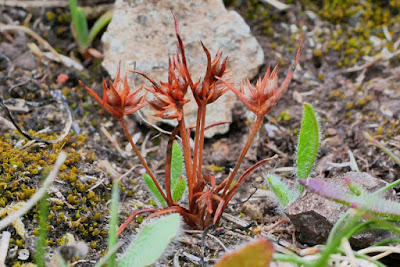The geology of the Lizard area is well documented as are the plants that grow there. However, it is a very large area and it would take a long time finding these rare plants unguided. So what better way to have an introduction to the area than with a guided botanical walk with the Cornwall Botanical Group.
This is a blog containing the rarer species found, along with anything else I found interesting on the day. As there are so many species I will limit my ramblings and show you as many photos as possible.
I'll start off with the rarer Clovers as many botanists and students studying ecology visit there to see them. Below is Twin headed Clover, though all the ones we saw this day had single flower heads (probably due to drought).
Trifolium bocconei
Upright Clover
Trifolium strictum
Knotted Clover
Trifolium striatum
Rough Clover
Trifolium scabrum
Birdsfoot Clover
Trifolium ornithopioides
Slender Trefoil
Trifolium micranthum
Long Headed Clover
Trifolium incarnatum subsp molinerii
Western Clover, the biggest of all the above, but still half the size of White Clover.
Trifolium occidentale
So now you know there are a few more clovers than Red or White ones!
Wild Chives on a rocky outcrop
Allium schoenoprasum
The
red form of Shepherd's Purse, though I have seen ordinary plants
looking as red as these. Im sure there are some other differences
between them too. Found in the Lizard car park area.
Capsella rubella
Also found in the car park were copious amounts of Green Sea-spurrey, much smaller than our native ones found in salt marshes.
Spergulria bocconei
I learnt a new sedge to identify and have seen it in several places since this visit, Flea Sedge.
Carex pulicaria
Dropwort is quite at home on the poor soils of the serpentine rocks.
I used to only see it on chalk back East.
Filipendula vulgaris
Found in the Lizard main car park was Western Ramping Fumitory, locally known as Cornish Ramping Fumitory as it's only found in Cornwall and is also endemic (only found here in the world).
Fumaria occidentale
Petty Whin is very rare most everywhere, a thin, spindly bush with weak spines. On the Lizard it sprawls through other plants and thrusts up the odd branch and flower cluster between them.
Genista anglica
A
related species was also in flower which are very similar to those
above, Dyer's Greenweed. It was the procumbent subspecies that can
survive being blasted by salt laden gales that happen here frequently
over the cooler months. Oh and what a view too!
Genista tinctoria subsp littoralis
Look for this type of sparse, thin soil over granite habitat for the tiny Clovers.
A change of rock led to a change of wildflower. This below was one of hundreds of Bloody Cranesbills.
Geranium sanguineum
Scattered over the rocks in places and also in the main Lizard car park was Fringed Rupturewort, one of several new species I saw today.
Herniaria ciliolata
Spotted Cat's Ear, another rare species.
Hypochaeris maculata
A very rare fern, Land Quillwort. The corm is usually buried but this had been kicked up by cattle we suspect. It gave us a unique opportunity to see the whole plant. Spores form on the underside of the leaves to disperse the plant by wind.
Isoetes histrix
Toad Rush abounded, but we also found the very small Dwarf Rush, not far away from the Chives.
Juncus captitatus
One of the stars of the trip was this plant, parasitic on Wild Thyme, it was of course, Thyme Broomrape.
Orobanche alba
Pillwort
is an even smaller fern, dispersing its spores by forming a pill like
ball at the base of the simple frond. Found in dried up winter puddle
areas.
Pilularia globulifera
Another amazing plant to see was Spring Sandwort, a bit larger than its common cousins with proper petals too!
Sabulina verna
Incredible scenery surrounded many of these plants. Here's Dropwort with an amazing backdrop.
Close by were numeorus Pale Butterworts, which is much more common in Cornwall. It's also smaller in all parts than Common Butterwort.





































No comments:
Post a Comment
All comments are moderated before publication, so please don't bother spamming me, thank you. Genuine comments most welcome.